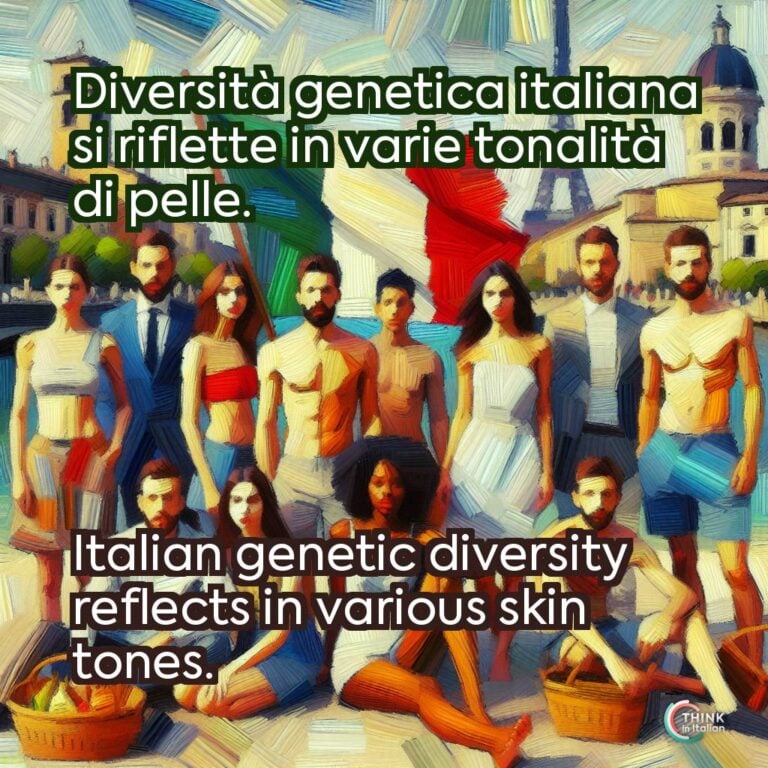Are Italians White? Historical, Social, and Cultural Roots
The question of whether Italians are “white” unravels a complex web of history, social constructs, and regional diversity. Understanding the roots of this question reveals how perceptions of race and identity have evolved.
First of all, I want to underline that for the mere informative purpose of this article, I will not consider race as a biological reality. For me, race it a social construct that changes over time and across cultures.
Skin color and ancestry are often used as markers to categorize people, but these categories are shaped by political, historical, and cultural forces rather than scientific consistency.
In modern Western frameworks, Italians today are generally seen as white. However, this was not always the case, especially in the United States during the late 19th and early 20th centuries.
Italy’s regional diversity challenges any simplistic racial categorization. In fact, the country has historically been fragmented into city-states, kingdoms, and regions. This led to several waves of migrations, invasions, and trade.
Luckily enough, if I may say, these influences have shaped the genetic and cultural heritage of modern Italy, making it the wonderful mosaic that we know today.
Historical Context
Italian Immigrants in the United States
The roots of this question trace back to early 20th-century America, where Italian immigrants faced significant discrimination.
In a racially stratified society, being classified as white used to mean having access to social privileges, citizenship, and economic opportunities.
Italians, just like other Southern and Eastern Europeans, were often considered outsiders and, for this reason, they faced racism, exclusion, and violence.
Southern Italians, many of whom have mixed ancestry from Mediterranean and North African influences, were the most marginalized because of their darker skin tones and cultural differences, which made them targets of prejudice.
The Role of Colonialism
Italy’s colonial ventures in Africa during the late 19th and early 20th centuries reinforced its identity as a European nation and, by extension, “white”.
In colonies like Libya, Ethiopia, and Somalia, there were racial hierarchies that highlighted differences between Italians and African populations, reinforcing the idea that Italians were part of a superior European group.
However, Italy’s colonial efforts were less extensive and organized compared to other European countries, and the impact of these racial ideas is still debated today.
Modern Migration and Changing Demographics
In recent decades, Italy has become home to significant migrant communities from Africa, Asia, and Eastern Europe. This has introduced greater ethnic diversity and challenged traditional notions of Italian identity.
Afro-Italian and Asian-Italian communities are now visible and integral parts of the society, but they often face barriers to be fully recognized as “Italian”.
The increasing diversity raises questions about how Italian identity is defined in the 21st century. Can it still be tied to whiteness or European ancestry, or is it evolving into something broader and more inclusive?
Of course, this topic extends far beyond a simple discussion of migration’s social and geographical aspects, as it is deeply connected to political debates, which will not be discussed here.
Regional and Genetic Diversity in Italy
North vs South
Northern Italians are genetically more similar to Central Europeans than to the rest of the country, given their links to Celtic and Italic tribes. They are often lighter-skinned, reflecting adaptations to a cooler, less sunny climate.
Southern Italians are marked by the Greek colonization, the Arab influence, and the proximity to the Mediterranean and North Africa. They generally have darker skin tones, an adaptation to stronger sunlight.
Sardinia: A Genetic Time Capsule
Sardinians have unique genetics because their island has been isolated for a long time. Their DNA still shows traces of ancient populations, from migrations that happened before many of the changes seen in mainland Italy.
Environmental Factors
Italy is characterized by a rich and wide geographical range, that extends from the Alps in the north to the Mediterranean in the south. This geographic variability has contributed to skin color variations.
Melanin levels, influenced by climate and sunlight, result in Southern Italians typically having darker complexions than their Northern counterparts, as mentioned before.
Philosophical and Ethical Implications
- Does it Matter? For Italian Americans in the early 20th century, being classified as white was crucial for survival in a racially stratified society. Today, the question feels less relevant as societies increasingly embrace diversity and inclusion.
- What Does It Reveal? This question highlights the limitations of racial labels and the need to move beyond superficial categorizations. Italian identity is a testament to the fluidity of cultural and racial boundaries, offering lessons in the richness of human diversity.
The question “are Italians white?” defies a simple yes or no answer. It is a reflection of historical, social, and cultural forces that shaped perceptions of race and identity. In sum, for me Italian identity cannot be reduced to skin color.
Rather than fixating on racial categories, it is more meaningful to celebrate the rich tapestry of Italian history, culture, and diversity.
Italy’s story reminds us that identity is far more complex than any label and that embracing this complexity is key to understanding both Italians and the broader human experience.






